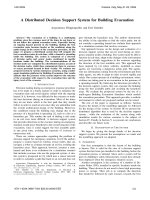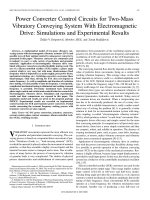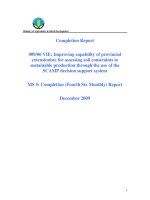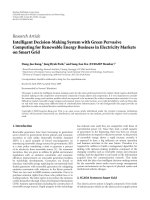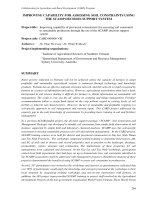An advance clinical decision support system, with knowledge discovery, integration and management features
Bạn đang xem bản rút gọn của tài liệu. Xem và tải ngay bản đầy đủ của tài liệu tại đây (1.2 MB, 150 trang )
HealthWARNer: AN ADVANCE CLINICAL DECISION
SUPPORT SYSTEM, WITH KNOWLEDGE DISCOVERY,
INTEGRATION AND MANAGEMENT FEATURES
Farhan Gul
(BSc. GIK)
A THESIS SUBMITTED FOR
DEGREE OF MASTER OF SCIENCE
DEPARTMENT OF COMPUTER SCIENCE
NATIONAL UNIVERSITY OF SINGAPORE
2005
Summary............................................................................................................................ 4
List of Abbreviation.......................................................................................................... 6
Index of Figures................................................................................................................. 7
Index of Tables .................................................................................................................. 7
Chapter 1: Introduction ................................................................................................... 8
1.1 Motivation.................................................................................................................... 8
1.2 Scope of Research and Contributions ..................................................................... 11
1.3 Organization of this thesis........................................................................................ 12
Chapter 2: Background.................................................................................................. 16
2.1 Competing Technologies for base work of HealthWARNer................................. 17
2.1.1 Criteria for selecting base work for HealthWARNer .....................................17
2.1.2 Discussion on existing research projects ........................................................19
(1) ASBRU...........................................................................................................19
(2) GEM ...............................................................................................................21
(3) EON................................................................................................................23
(4) GUIDE ...........................................................................................................25
(5) PROforma.......................................................................................................26
(6) Protégé............................................................................................................28
(7) GLIF ...............................................................................................................29
(8) Arden Syntax..................................................................................................31
2.1.3 Comparison amongst competing technologies ...............................................33
2.1.4 Decision ..........................................................................................................36
2.2 Research Problem ..................................................................................................... 38
2.2.1 Arden Syntax ..................................................................................................38
Implementation ....................................................................................................38
Applications of Arden Syntax..............................................................................39
Structure of MLM ................................................................................................39
Versions of Arden Syntax....................................................................................46
2.2.2 Problems Identified and their Importance.......................................................47
(1) Poor Healthcare Enterprise Knowledge Integration.......................................47
(2) No Process to discover new Knowledge and measure its Efficiency ............48
(3) Not easy to Adopt...........................................................................................50
(4) Lack of Interest of users in Knowledge Creation Activity.............................50
(5) Outdated MLM file format.............................................................................52
(6) No Separation between Knowledge and Clinical Data ..................................53
(7) Lack of Capability to Perform Disease Surveillance .....................................53
2.2.3 Problem Statement..........................................................................................54
2.3 Comparison of HealthWARNer with the earlier research work.......................... 55
2.3.1 Knowledge Efficiency Measurement and Discovery .....................................55
2.3.2 Knowledge Integration....................................................................................56
2.3.3 Healthcare Participation..................................................................................56
2.3.4 Sharing Centralized Knowledge Base and Processing Engine .......................57
2.3.5 Clinical Error Prevention ................................................................................57
Chapter 3 Design overview ............................................................................................ 58
3.1 Knowledge Efficiency ............................................................................................... 58
1
3.2 Knowledge Discovery................................................................................................ 59
3.3 Knowledge Integration ............................................................................................. 62
3.3.1 Use of Clinical Standards................................................................................62
3.3.2 Use of XML Representation ...........................................................................63
3.3.3 Conversion Tool..............................................................................................63
3.3.4 Central Knowledge Base and MLM Processing Engine Sharing ...................63
Chapter 4: Knowledge Creation, Evaluation and Improvement ............................... 67
4.1 Addition of Intention, Outcome and Event to evaluate accuracy of knowledge .. 67
4.2 Measuring Efficiency of Knowledge........................................................................ 70
4.3 Cycle of Knowledge Creation .................................................................................. 72
4.3.1 The role of humans .........................................................................................73
Knowledge Expert ...............................................................................................73
Knowledge Translator..........................................................................................73
Knowledge Authenticator ....................................................................................74
4.3.2 Computer-Human Interaction (Question and Answers) .................................74
i. Intention related ................................................................................................75
ii. Outcome related...............................................................................................75
iii. Logic related...................................................................................................75
4.3.3 Active Knowledge ..........................................................................................76
4.3.4 Crude Knowledge ...........................................................................................76
4.3.5 Efficiency Measurement .................................................................................76
4.3.6 MLM History ..................................................................................................77
4.3.7 Knowledge Authentication .............................................................................78
4.3.8 Example Scenario ...........................................................................................78
4.4 Improving Healthcare Provider Participation in Knowledge Creation .............. 80
4.4.1 Cycle of Knowledge Creation.........................................................................81
4.4.2 Audit of Treatment Process ............................................................................81
Chapter 5: Healthcare Enterprise Knowledge Integration ........................................ 83
5.1 Use of Clinical Standards ......................................................................................... 83
5.2 Arden Syntax XML Representation........................................................................ 85
5.2.1 Use of XML ....................................................................................................85
5.2.2 Conversion Tool..............................................................................................86
Chapter 6: Centralized Knowledge Base and MLM Processing Engine Sharing .... 87
6.1 Architecture............................................................................................................... 87
High Level Design ...................................................................................................88
Deployment Strategies .............................................................................................93
6.2 Centralized Knowledge Base and Process Sharing................................................ 95
Rationale and Benefits of Using WebServices ........................................................95
Design Problems ......................................................................................................95
Chapter 7: Implementation........................................................................................... 99
7.1 Knowledge Acquisition Wizard ............................................................................... 99
7.2 MLM Knowledge Management Application........................................................ 101
7.2.1 Roles .............................................................................................................101
7.2.2 Actions ..........................................................................................................101
7.2.3 Create New MLM .........................................................................................102
2
7.2.4 Modify MLM ................................................................................................103
7.2.5 Import MLM .................................................................................................104
7.2.6 MLM History ................................................................................................105
7.2.7 Translations...................................................................................................106
7.2.8 Users .............................................................................................................107
7.2.9 Roles .............................................................................................................108
7.2.10 Setting and Logout......................................................................................108
7.3 Tools ......................................................................................................................... 109
Chapter 8: Conclusion.................................................................................................. 110
8.1 Evaluation................................................................................................................ 110
8.1.1 Structure of the System.................................................................................110
Functionality Completeness...............................................................................110
System Completeness ........................................................................................111
8.1.2 Performance ..................................................................................................111
Bottlenecks of HealthWARNer .........................................................................111
Clinical Testing..................................................................................................113
8.2 Test Scenario ........................................................................................................... 113
8.2.1 The Knowledge.............................................................................................114
8.2.2 Knowledge Integration..................................................................................114
8.2.3 Alert ..............................................................................................................115
8.2.4 Efficiency Measurement ...............................................................................115
8.2.5 New Knowledge Discovery ..........................................................................115
8.3 Contributions........................................................................................................... 117
8.3.1 Knowledge Discovery Process .....................................................................117
8.3.2 Knowledge Efficiency Calculation ...............................................................117
8.3.3 Enterprise Knowledge Integration ................................................................117
8.3.4 Easy to Adopt................................................................................................118
8.3.5 XML based MLM .........................................................................................118
8.3.6 Improved HealthCare Provider Participation................................................118
8.3.7 Disease Surveillance .....................................................................................118
8.4 Future Research ...................................................................................................... 119
8.5 Conclusion ............................................................................................................... 120
REFERENCES.............................................................................................................. 123
Appendix A: MLM Examples...................................................................................... 132
Example 1 ASCII Based text MLM.......................................................................132
Example 2 Anthrax.mlm: XML Based MLM........................................................134
3
Summary
HealthWARNer is an advanced clinical decision support system for minimizing clinical errors
of clinicians through clinical alerts generated based on Medical knowledge stored in its
knowledge base. It allows clinical knowledge to be shared and reused across healthcare
institutions without any manual modifications. HealthWARNer includes processes known as
‘Cycle of Knowledge Creation’ to help discover new knowledge and constantly evaluate
existing knowledge. The system automates the process of generating statistical information to
rate medical knowledge so that the right judgment can be made in choosing a better treatment
process amongst alternatives or to replace a poorly performing clinical procedure with a better
one. These statistics are generated each time a patient undergoes a treatment.
HealthWARNer is built upon Arden Syntax, which defines the structure of MLMs. These
MLMs hold clinical knowledge for making clinical decisions. MLMs are computer
interpretable and have been proven by various studies (discussed later) to reduce chances of
clinical errors significantly. Arden Syntax was chosen because it is better suited for
generating clinical alerts to prevent clinical errors than other more elaborated methods such as
GLIF and PROforma. The latter are typically designed for complex treatment plans of
chronics diseases. Arden Syntax is also a mature technology with a simple and efficient
knowledge model that has received widespread acceptance from standardization bodies and
commercial vendors. We have built upon Arden Syntax in HealthWARNer to make the
knowledge format more portable by leveraging on medical standards and the use of more
powerful and open IT standards such as WebServices and XML. This allows multiple
institutions to share a Central Knowledge Base, which accelerates knowledge discovery as
knowledge can be applied, tested and evaluated much more frequently and in a wider scope
than in the case of a single healthcare institution. Moreover, the Centralized Knowledge Base
4
helps to improve the control and management of mission critical clinical tasks such as in
detecting and managing disease outbreaks and biological attacks.
We have conducted some tests on HealthWARNer to evaluate whether it has met our research
objectives. We found that our new representation of knowledge using clinical standards in
XML format can be used to trigger alerts and notify Healthcare providers of possible clinical
errors. We tested the mechanism to measure knowledge efficiency and the process to capture
new knowledge. The knowledge efficiency results were properly recorded in the history each
time the knowledge was executed. We also discovered some new knowledge in the test
scenarios, which clearly indicate the success of our concept and HealthWARNer
infrastructure for the process of knowledge creation. To test the disease surveillance
capabilities of HealthWARNer, we deployed knowledge in a Central Knowledge Base to
detect Anthrax exposure in a patient. This knowledge base was shared amongst multiple
simulated healthcare institutions. The outcome of this test scenario was successful as the
expected warning was generated as soon as we entered dummy patient symptoms similar to
Anthrax exposure in either one of the healthcare institutions.
5
List of Abbreviation
ASTM
American Society for Testing and Materials
CPG
Clinical Practice Guidelines
CPMC
Columbia/Presbyterian Medical Center
DTD
Document Type Definition
GEL
Guideline Expression Language
GEM
Guideline Element Model
GLIF
Guideline Interchange Format
GQAQ
Guideline Quality Assessment Questionnaire
GUI
Graphical User Interface
ICD
International Statistical Classification of Diseases
J2EE
Java 2 Enterprise Edition
LOINC
Logical Observation Identifiers Names and Codes
MLM
Medical Logic Modules
NDC
National Drug Code
PSM
Phase-shifting mask
UDDI
Universal Description, Discovery and Integration
XML
Extensible Markup Language
XSL
Extensible style-sheet Language
6
Index of Figures
Figure 1.1: Clinical Errors ………...…………………………………………………………. 8
Figure 3.1: Cycle of Knowledge Creation …………………………………………..……… 60
Figure 3.2: HealthWARNer Deployment Scenario ………………………………...………. 64
Figure 6.1: HealthWARNer Architecture……..…………………………………….………. 88
Figure 6.2: MLM Alert Notification Window .……………………………………..………. 93
Figure 6.3: HealthWARNer Distributed Deployment …………………………...…………. 94
Figure 7.1: Knowledge Acquisition Wizard ……….…………………………………..…. 100
Figure 7.2: Specify new Logic ………….………………………………………...……… 100
Figure 7.3: Add new MLM ……………….………………………………………………. 103
Figure 7.4: Edit MLM ……………………..……………………………………………… 104
Figure 7.5: MLM History ……….………….…………………………………..……...… 105
Figure 7.6: Translators Task List …………………………………………….……………. 107
Figure 7.7: Users ………………………………………………………………….…….…. 108
Index of Tables
Table 1.1 Problem-Solution Summary ...…………………………..……………….………. 14
Table 2.1 Comparison between Guideline Modeling Techniques ………………...…………34
Table 2.2 Comparison Results ……………………………………………………………… 36
Table 2.3 Survey Results …………………………………………………………...………. 52
Table 4.1 Accumulated knowledge ranking …………………………………….....………. 71
Table 7.1 Roles and Allowed Actions ……………………………………………………. 102
7
Chapter 1: Introduction
1.1 Motivation
HealthWARNer is intended to reduce unnecessary injury and sometimes the loss of human
life due to clinical errors by healthcare professionals. The alarmingly high number of deaths
caused by clinical errors prompted this work. The severity of this problem is reflected in the
following abstracts of key findings of several recent studies:
•
A survey done by the Philadelphia Inquirer and published in September 1999 showed
the severity of this problem (Figure 1.1). It reports approximately 120,000 deaths and
one million injuries in US in a year due to clinical errors.
Philadelphia Inquirer Sunday,
September 12, 1999
Figure 1.1: Clinical Errors
8
•
An article published in JAMA [27] shows a total figure of 225,000 deaths in a year
caused by iatrogenic causes, including unnecessary surgery, infections and adverse
effects of medicine.
•
Another publication [39] reports a total iatrogenic death figure of 783,936.
•
CNN has quoted a report from National Academy of Sciences’ Institute of Medicine a
figure of yearly deaths between 44,000 to 98,000 in 1999. Note that even 44,000 is a
bigger number as compared to annual deaths caused by road accidents, breast cancer
or AIDS.
It is worth noting that the figures reported in these reports are very high and the studies were
conducted in United States, which has one of the highest expenditure on healthcare with a
well-known higher quality of healthcare standards and regulation compared to many other
countries. Though there are no similar studies done for Third World countries, we can easily
be convinced that the fatal rate due to clinical errors will be higher in these developing
countries.
Over time, different means have been developed to moderate the escalating number of deaths
due to clinical errors. One of the earliest solutions was the creation of clinical guidelines. A
Clinical guideline is defined as a written statement how a certain task has to be fulfilled in a
clinical context. But as they were only available in text format that were not interpretable by
computer programs, it was awkward for healthcare providers to refer to those documents
while they were treating the patients. This inaccessibility of knowledge at the point of care
resulted in the ineffectiveness of the guidelines in preventing clinical errors. A major leap was
made by the use of Alert bases clinical decision support systems, which has brought clinical
rules and guidelines to the point of care. These systems would detect clinical conditions
9
specified in the knowledge and generate alerts/reminders to healthcare providers of possible
clinical errors and provide its recommendations. This minimizes clinical errors by sending
alerts and reminders at the appropriate time when it was needed.
Below is a list of studies conducted to evaluate the effectiveness of clinical decision support
systems in preventing clinical error and its impact on the cost of treatment
•
The study for Perioperative Antibiotic Administration [28] conducted during the
period of 1988 to 1994 concluded a decline in perioperative wound infections from
1.8% to 0.9%. It also noted a decline in average number of doses of antibiotics
administered from 19 to 5.3, which correspondingly caused a decline in cost per
treated patient from $123 to $52
•
The study on POE with decision support implementation [29] over a period of four
years showed that missed-dose medication error rate had fallen by 81% while
potentially injurious errors fell by 86%
Based on the above observations and some other publications [61, 62, 63], we conclude that
clinical decision support systems can reduce chances of human error and lower medical cost.
Here we should emphasize that these findings are for alert based systems implementing
simpler guidelines and clinical rules. The same conclusion may not be applied to the use of
complex guidelines, which can be executed in several parallel or concurrent plans in various
orders.
In reality, it is not sufficient for a solution to prevent clinical errors by expressing knowledge
in computer interpretable format and having a clinical decision support system to generate
alerts and reminders based on that knowledge. Generating alerts and reminders would help in
reducing chances of clinical errors but it can only be as accurate as the knowledge itself,
10
which is used to generate those alerts and reminders. As clinical practices/procedures are
being revised and updated regularly, clinical knowledge stored in such system should also be
updated accordingly or it would become obsolete. Therefore a bigger challenge for clinical
decision support system would be to find a way through which clinical knowledge can
automatically be evaluated and updated in the background based on its effectiveness in
treating patients. This is the primary focus of HealthWARNer.
Since such systems already have knowledge in computer interpretable form, it makes a lot of
sense if the knowledge representation is standardized so that it can be easily integrated with or
reused by other systems. This is similar to the field of Electronics, which is seeing great
benefits from creating reusable technologies that can be easily reused and integrated as a
component in another system. Unfortunately medical informatics is far behind when it comes
to knowledge integration, as it is relatively immature. At the moment, Arden Syntax, the
modeling method of clinical guidelines widely accepted by most healthcare standardization
bodies and adopted in many commercial implementations (discussed in section 2.1.3) is
expressing the knowledge in a format that cannot be used by another healthcare institution
without manual changes. This is mainly due to its curly braces problem [36].
1.2 Scope of Research and Contributions
HealthWARNer is designed to generate alerts and reminders to minimize or prevent clinical
errors. The approach used is Rule-based methodology for modeling clinical knowledge,
which is deemed more effective for handling clinical errors as demonstrated by the related
studies mentioned previously in section 1.1. The scope of this research does not include
modeling of complex multi-step guidelines, which are more suitable for the treatment of
chronic diseases.
11
The main research objective and our accomplishment are the processes for refinement of
clinical knowledge in HealthWARNer. These processes also constantly attempt to discover
new knowledge and involve the healthcare providers in the process of discovery. This helps in
keeping the knowledge up to date and accurate so that it is more effective for preventing
clinical errors. Secondly, we have contributed central processing engine architecture, which
can be used by multiple healthcare institutions simultaneously. This extends the scope of
traditional Arden Syntax based system across clinical boundaries making it more
comprehensive and efficient in detecting clinical errors. Moreover this makes the system easy
to adopt, simplifies its management and allows mission critical clinical operations such as the
early detections of disease outbreaks and biological attacks.
Additional research objective of HealthWARNer is the extension of Arden Syntax (to be
discussed in section 2.2.1). Though Arden Syntax has many useful features and has been
fairly successfully applied for moderating clinical errors [28, 29] in several systems, it still
has at least two major shortcomings that should be dealt with. First is its curly braces
problem [36], which, if is overcome, can lead to better knowledge integration, sharing and
reuse. Second, Arden Syntax uses text-based ASCII file format, which is out-dated and
inferior for representing knowledge as compared to more advanced format such as XML. We
have also achieved these objectives.
1.3 Organization of this thesis
We proposed the design and implementation of HealthWARNer - a prototype of advanced
clinical decision support system for minimizing clinical errors of clinicians through clinical
alerts generated based on Medical knowledge stored in its knowledge base. Several related
research issues and technical problems (listed in Table 1.1) will be addressed in this project as
our design objectives. In Table 1.1, the top row of the table lists the issues/problems that we
12
are addressing in this thesis and the left column outlines our solutions or approaches to
resolve them. We are using “ ” to link the proposed solution/approach to the respective
issue/problem.
13
Chapter 7
Chapter 6
Chapter 5
Solutions
Chapter 4
Cant perform disease surveillance
No Separation between Data and
Knowledge
MLM File Format is outdated
Poor healthcare Provider
participation in knowledge
creation activity
Not easy to adopt by healthcare
institution & compiler
implementation required
No Healthcare Enterprise
Knowledge Integration
(Share/Reuse knowledge)
Cannot evaluate knowledge
efficiency
No process for new Knowledge
Discovery
Problems
Arden Syntax
enhancement
(IntentionOutcome,
events)
Knowledge
efficiency
calculation
Audit
Cycle of
Knowledge
Creation
process
Use of
Medical
standards
XML DTD for
MLM
Conversion
Tool for MLM
Central
processing
engine
(WebServices)
Central
Knowledge
Base
Security
(private /
public)
Knowledge
acquisition
wizard
MLM
Knowledge
management
Application
Table 1.1: Problem-Solution Summary
14
Table 1.1 also outlines the thesis contents, as the solutions/approaches represented in rows are
grouped into chapters. Briefly, in Chapter 2, we will have a comprehensive discussion of the
clinical decision support systems and their implications on the design of Clinical Practice
Guidelines. We will compare various technologies that could be used for the design and
discuss how we derived at the conclusion of using Arden Syntax as our base system. After
that, we will summarize the shortcomings of Arden Syntax and some useful enhancements
that will be carried out in the thesis. At the end of Chapter 2, we will do a comparison of
HealthWARNer features with similar work done by earlier researchers.
Chapter 3 provides a design overview of HealthWARNer. We will discuss in details in
Chapter 4 to Chapter 6 how HealthWARNer addresses the research issues and problems that
have been identified. In Chapter 4, we explain the enhancements made to Arden Syntax in
order to improve its efficiency in knowledge representation and for supporting the discovery
of new knowledge. Chapter 5 presents the process of Knowledge Integration and explains
how HealthWARNer’s representation of knowledge is superior to its predecessors. In Chapter
6, we will highlight the benefits of sharing the MLM Processing Engine as WebService and
having a Central Knowledge Base, which multiple organizations can share.
In Chapter 7, we will discuss the implementation and evaluation of the HealthWARNer
prototype. The knowledge management and acquisition tools provided with HealthWARNer
would also be addressed in this chapter.
Lastly, in Chapter 8, we will conclude the thesis. We would also provide some pointers for
future research on this topic.
15
Chapter 2: Background
In this chapter, we present an overview of background work related to HealthWARNer.
Research work in clinical decision systems had started more than two decades ago; groups of
researchers have been working on refining a number of technologies for years. There is a
variety of available technologies which we could leverage upon, however, the motivations of
our design has necessitated some requirements which help us to narrow down the range of
technologies that are suitable as the base technology. The requirements eliminated the
suitability of most of these techniques leaving us with Arden Syntax.
In the first section of this chapter, we will highlight the scope and requirements of
HealthWARNer with which are used to assess the suitability of the various technologies.
Then, we will outline in detail the various technologies, examine each of their strengths and
weaknesses and explain how we finally short-listed Arden Syntax as the most suitable for our
base technology.
Arden Syntax, in addition to being the most suited for our requirements, is also a mature and
well-accepted standard technology. However, our research revealed some problems in Arden
Syntax, which we think, are important to resolve. In the second section, we will look into
these problems and explain why they are important to solve and then draw up a problem
statement for HealthWARNer.
Finally, in the last part of this chapter, we would summarize and make a comparison between
HealthWARNer and the other similar technologies to demonstrate its superiority in the
context of our research objectives.
16
2.1 Competing Technologies for base work of
HealthWARNer
In this section, we will begin with listing out the criteria based on our requirements for
HealthWARNer. These criteria will be used to judge which of the earlier work would be more
suitable as base work for HealthWARNer. We will also identify and describe related projects,
each of which is potentially useful as a base for the development of HealthWARNer. Finally,
we will do a comparison based on our criteria to find out which of the competing technologies
would be most suitable to be used as foundation for HealthWARNer.
2.1.1 Criteria for selecting base work for HealthWARNer
In this sub-section, we first outline the basic functional requirements of HealthWARNer.
These functional requirements are derived from the initial motivations for this project as
discussed in section 1.1. In short, our primary motivation is the prevention of clinical errors
and in order to achieve this objective, the proven way is to use the rule-based clinical decision
support systems, which model simple clinical guidelines. Knowledge Integration, Knowledge
Efficiency Measurement and to invent processes for new knowledge discovery are also our
motivation from the onset of this project.
The four basic functional requirements of HealthWARNer are as follows:
(a) Clinical Decision Support System
In section 1.1, we discussed that the prevention of clinical errors and lowering its cost are the
main motivation factors for HealthWARNer project. We have also highlighted some solutions
[28,29] which indicate that alert based [33, 34] clinical decision support system can help
17
address these issues. It is therefore important for HealthWARNer to have a clinical decision
support capability.
(b) Model Clinical Practice Guidelines
All clinical decision support systems have a knowledge component, which they use to make
decisions and recommendations. Generally, the knowledge represented in these systems is
referred to as CPGs, which are created by healthcare experts inventing best practices for
diagnosis and treatment. The CPG can range from simple clinical rules to very complex
treatment plans, which are generally used to treat chronic illnesses. As discussed in section
1.1, the simpler guidelines are more suitable for a system, which generates clinical alerts and
reminders for error prevention [28, 29, 61, 62, 63]. Therefore HealthWARNer must be able to
model simpler guidelines.
(c) Clinical Standard for Knowledge Sharing
Representing Clinical Practice Guidelines in a form that computer can interpret has been
addressed in many projects which we shall discuss later in this chapter. The next step for
knowledge representation is automated knowledge integration, which would allow CPG
knowledge to be shared and reused across healthcare organizations in a seamless manner. To
achieve this and to have a widespread use, the knowledge representation has to be accepted as
a standard. Hence it is important for HealthWARNer to adopt some standardized methods for
clinical knowledge representation.
(d) Commercially Accepted Technology
HealthWARNer should leverage as much as possible on well-accepted
methods/techniques that have been proven practical and workable in real world
18
environment. As discussed in the studies in section 1.1, it is much needed to have
decision support systems that can improve healthcare quality and reduce the alarmingly
high occurrences of clinical errors. This is an attractive commercial opportunity, which
many commercial vendors would like to exploit. We want to base HealthWARNer on a
reliable system, so that at the end of the day, HealthWARNer too can be put to some good
use, rather than struggle with issues related to the base technologies
2.1.2 Discussion on existing research projects
There are a number of Clinical Practice Guidelines modeling projects that can provide clinical
decision support. These are: ASBRU [5, 20, 21], GEM [11, 17], EON [4], GUIDE [44, 45],
PROforma [6, 19], Protégé [22, 38], GLIF [9, 10, 18], Arden Syntax [16], PRODIGY [7] ,
GASTON [48, 49], GLARE [50, 51], Prestige [52] and DILEMMA [8]; the following
Clinical Practice Guideline modeling methods are still under development: SAGE [53] and
DeGel [54]. In the following section, we will provide a summary of some of these
technologies, excluding those still under development and the less popular work, of which
references are given for further information.
(1) ASBRU
Developed by:
ASBRU was developed under ASGAARD project.
Standard:
Accepted as a standard by ASTM.
Commercial Implementation/vendors:
19
TBA.
Description and Strengths:
ASBRU [5, 20, 21] is a skeletal plan-representation language to represent time oriented
hierarchical clinical guidelines. Using ASBRU, treatment plan can be defined. These plans
have specific intensions and can be executed sequentially, in parallel or in any defined order.
ASBRU defines mutually exclusive plan instance states like activated, suspended, aborted and
completed. Once a plan has been activated, it can only be changed to suspended, aborted and
completed state. If a plan is suspended it can be activated again, but this is not possible in the
case of aborted or completed. However, a new instance of the plan can be created in this case.
ASBRU plans have five components: preference, intentions, conditions, effects and plan
body. It also defines generic guideline plan that are evaluated first to find whether they are
suitable to be executed or not. The states defined for them are ignored, considered, possible,
rejected and ready. Various conditions are checked before the state is set to ready or rejected.
To handle uncertainty of time duration, starting time and ending time in a treatment plan,
ASBRU provides TIME ANNOTATIONS. Using these annotations, minimum and maximum
time limits can be specified. This is useful as treatment might show its results sooner or later
depending on patient conditions.
A publication [41] concluded that the temporal data abstraction and support for diagnoses and
treatment of ASBRU is more superior then its comparable approaches: PROforma, GLIF and
EON.
Tools Provided:
AsbruView and AsbrUI
20
While executing patient data, the duration and success/failure of actions have to be provided
to its engine. This interaction is often complex and hard to understand for medical expert so
user-interfaces like AsbruView [30, 31] and AsbrUI [32] have been developed to overcome
this problem.
Weakness:
Skeletal plan representation is a powerful way of reusing knowledge, however, it makes the
interdependencies and composition very complex and difficult to understand [56]
Learning Component:
No such feature available.
Current prominent work in Progress:
•
Development of an intermediate representation to visualize the hierarchy of ASBRU
language.
•
DeGel is extending some work of ASBRU.
•
Guideline Markup tool is a tool to convert free text to ASBRU language.
(2) GEM
Developed by:
Yale center for medical informatics.
Standard:
Accepted as a standard by ASTM.
21
Commercial Implementation/vendors:
None.
Description and Strengths:
GEM [11, 17] uses XML to represent a CPG and is computer interpretable. Using XML as
the language gives GEM an advantage of easy XSL transformation to other comparable
formats. An example for this is the published work by [42] which attempts to convert GEM
encoded guidelines to MLM format. Though the work showed a partial successful
transformation, mainly due to differences between GEM and Arden Syntax, there are good
chances of successful transformations to other guideline formats with similar characteristics.
The (DTD) that defines the structure of GEM representation of a guideline can be seen at
/>
Tools Provided:
GEM Cutter
Extracting knowledge and putting that information in GEM format is a tedious process, to
overcome this problem, GEM cutter is created. It has a GUI interface to make this process
easier.
GEM-Q
GEM-Q [43] is a new tool provided with GEM to evaluate the quality of Clinical Practice
Guideline. It is based on GQAQ approach.
Weakness:
One of its weaknesses is that GEM is just an abstraction of the guideline document and
therefore needs to depend on extrinsic systems to make it a useful clinical decision support
system. It has limited capabilities to tackle ambiguous parts of the guidelines. GEM is not
really comprehensive even though it extends the work of several researchers. It may require
22
extra elements, attributes, and relationships in order to adequately encode guidelines,
depending on the guidelines. [11]
Learning Component:
GEM-Q uses Guidelines Quality Assessment Questionnaire (GQAQ) [57]. GQAQ has a
guideline quality-rating instrument that comprised of 25 items, which evaluate the
development and format of guidelines, identification and summary of evidence, and
formulation of recommendations. GEM-Q uses XSL technology to automate this process of
quality assessment.
Current prominent work in Progress:
GEM II, which will be more comprehensive and usable.
(3) EON
Developed by:
Stanford medical informatics.
Standard:
None.
Commercial Implementation/vendors:
None.
Description and Strengths:
23
EON [4] is a set of software components and models for the creation of guideline based
application. It also includes guideline modeling and execution system. The guideline model is
called Dharma, which includes eligibility criteria, abstraction definition, guideline algorithm,
decision models and recommended actions. It also defines goals such as the ideal targeted
glucose level. Guideline algorithm can have action steps, decisions, synchronization nodes
and can generate recommendations. Protégé-2000 [38] is used for encoding EON guidelines.
EON also models domain ontologies, which is a view of patient data or virtual medical record
and other entities like roles in the organization. Patient data is obtained through either
database manager or user input.
An advantage of EON is that it allows the reuse of temporal queries and medical domain
knowledge.
Tools Provided:
None.
Weakness:
EON does not model execution state in its guideline representation model [58]. Execution
states allows a guideline execution thread to suspend, which is a good way to handle longterm guidelines.
Learning Component:
No such feature available.
Current prominent work in Progress:
24

